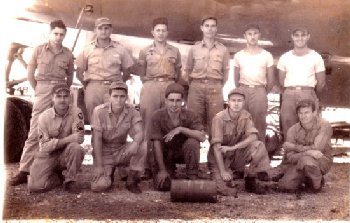 |
Taken
July 25, 1945
P-44 hardstand Guam |
Front
L to R: |
| M/Sgt
Lloyd (Gary) Geringer, FE; 1st Lt Julian (Jupe)
Arnold, Bomb; Sgt Lewis (Lew) Howard, TG; S/Sgt
Clarence (Jim) Martin, LG; T/Sgt Max Sampsel, CFC |
| Back
L to R: |
| 1st
Lt Charles Smith, Radar; Capt. Carroll (Buster)
Payne, AC; 1st Lt Edward (Ed) Dengler, Pilot; 1st
Lt Thomas (Tom) Brennan, Nav; S/Sgt Lloyd Volkmar,
Radio; S/Sgt Jerrell (Jerry) Taylor, RG |
| Note:
object in the foreground was the aircraft's honey
bucket |
This
mission was a daylight formation attack against Nakajima
Aircraft Plant at Handa. P-44 was element leader. The
radar bomb run was made through 10/10 undercast. All
of our bombs fell in the target area. A break occurred
in the dense clouds over the target and we were able
to take pictures. We dropped 500-pound general purpose
(G.P.) bombs from 17,500 feet. There were no fighters
and only moderate flak.
It turned out that a high percentage of the bombs dropped
by our formation were the only ones to hit the target.
All other squadrons in the 314th Wing missed the target
area. Post strike photos revealed that 35% of the bombs
toggled by our formation hit the target resulting in
it being 44.2% destroyed.
|
Strike
Photo of Handa
Nakajima Aircraft Plant |
Click
on photos above to enlarge |
|
|
enhanced
area of bombing explosions |
Click
on photos above to enlarge |
|
Strike
Photos...
The
above photo is one in a series strike photos taken with
(I believe) a K-17 mounted over the camera hatch just
aft of the radar compartment.
Intelligence
personnel drew in the purple lines to show the bombs
of each aircraft and noted our P-44 bombs since we were
leading the squadron.
The
entire run in from the IP was over a solid undercast.
Our course was from the bottom of the photo toward the
top on a northeasterly track. The target was difficult
for radar attack and we used the direct synchronous
method.
Our
bombardier, Jupe Arnold, called me on the interphone
and said that the bombs were going into the target.
I replied, "No shit". Colonel Mundy, flying in the right
seat with us, leaned over to Payne and told him we should
have more confidence. It was later that the Colonel
found out that the other eleven squadrons on the mission
had missed the target by as much as fifteen miles.
Our
bombing team: Navigator Tom Brennan, Arnold and I got DFC's for
our efforts. [Click here to view DFC Order]
|
Direct
Synchronous Method ... this means that I identified
the target aircraft plant in the radar return,
estimated the aim point location and fed data
to Jupe whose bombsight was synchronized with
my "computer" so that both tracked on that assumed
aim point. The difficulty for me as well as the
radar operators in all of the other lead crews
was first, interpeting the radar return to find
the target area, and second, putting cross hairs
on the aim point. When the indices on the bombsight
came together, the bombs were dropped, and the
other bombardiers toggled their bombs.
|
The above account, strike
photo of Nakajima Aircraft Plant - Handa, and
crew photo are courtesy of
Charles A. Smith, Radar Observer,
Crew 44 |
|





